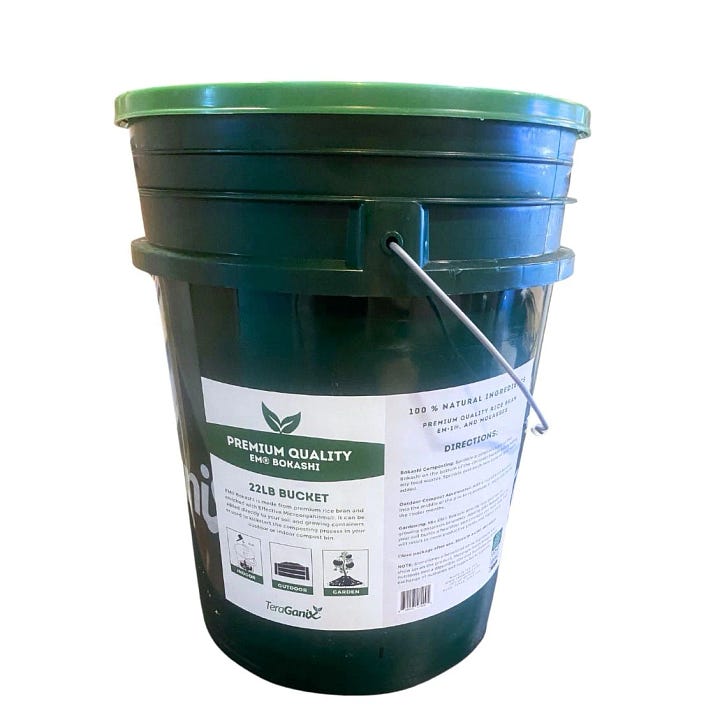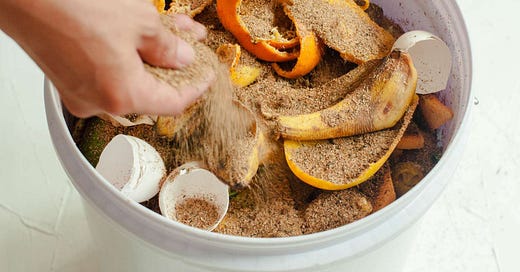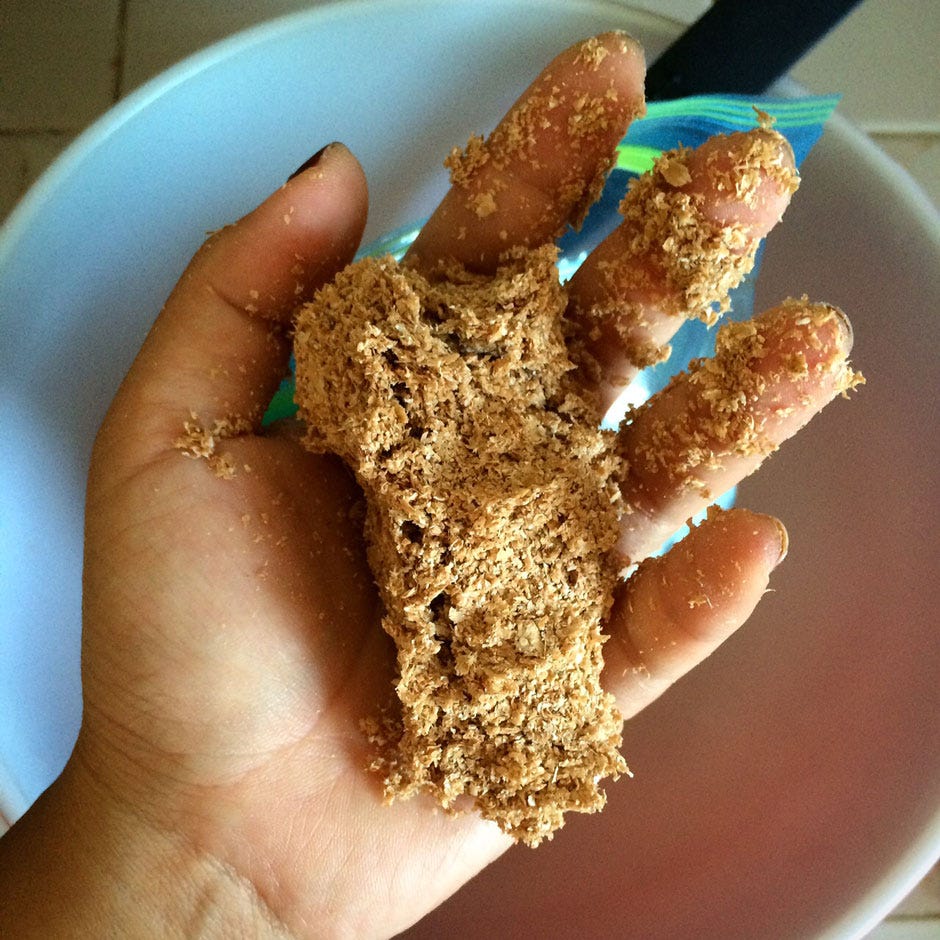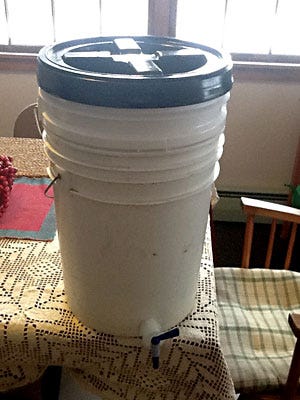Bokashi: A Deep Dive into Anaerobic Fermentation for Soil Amendment
Fermenting waste for our gardens
Bokashi is one of those things, people have heard about if you spend enough time in the organic/permaculture/biodynamic space, but it can seem a bit intimidating. Functionally it is similar to composting with extra steps, as well as a fermentation period. And I think for a lot of people, adding the extra step of fermentation can be a little intimidating, but I think it’s worth discussing what benefits exist from utilizing this technique, and figuring out when it is a good tool to use.
While not popular here in the United States, bokashi has a long history in southeastern Asia & Japan. The general idea is that it’s a composting process that uses a specific group of microbes to anaerobically ferment your waste, which leaves you with compost that can be quickly used by the microorganisms in the soil. Unlike traditional compost, you don’t need to measure out greens and browns, and it doesn’t generate heat or gasses, and all of the byproducts are contained within a closed system so nutrients aren’t lost in the composting process. This also means no smells—mostly—, no insects, and no rodent problems. Sounds pretty perfect right?
Now despite the fact I listed all those great things about bokashi, there might be some times when it’s not the right composting solution for you— and we’ll cover that. We’ve talked about anaerobic fermentation quite a bit before, but if it doesn’t sound familiar, I’d suggest reading our pieces on Korean Natural Farming and JADAM if you want a bit of a deeper dive, because I think a lot of things tie together from that episode and here. The point is that this isn’t technically a composting process, but a fermentation-led breaking down of the organic matter. Compost is an aerobic process reliant on oxygen; an anaerobic (oxygen-less) compost pile stinks and can cause damage to your soil. Bokashi is also an anaerobic process, but because of the fermentation, it doesn’t come with the same issues.
How long is the fermentation process for a Bokashi bucket? 2 weeks. In the previously mentioned content on KNF and JADAM, we talked about anaerobic fermentation with the use of L.A.B. and JMS in particular, and some of the key things about anaerobic fermentation are that there’s no oxygen and the pH of anaerobic conditions in the soil, or your food waste, is low. This reduces which types of microbes can survive in those conditions, and fortunately, methane-producing microbes can’t survive. However, lactobacillus (L.A.B.) thrives.
Now given how fermentation works— specific gasses are released while minerals are unbound from the rest of the, well, whatever you’re fermenting, we can make nutrients bio-available with minimal loss—the same way fermentation makes other foods more digestible for us. Now it’s not just LAB that’s doing this work but also Purple non-sulfur bacteria, or PNSB.1
Now, most folks using bokashi buckets aren’t out there harvesting their own LAB, they’re buying EM-1, which is just a prepackaged microorganism collection. EM–1 specifically was picked by Dr. Terou Higa for its ability to be successful for this particular use. Not only have they been used for the average bokashi bucket in an apartment, but have been used in sewage treatment plants and on farms.2,3
So your first question might be, well do we have to buy EM-1 then to do composting? Well, sort of. There are two methods to getting around this; one is to buy it once and know how to keep it alive, kind of like a sourdough starter and the other is to try to capture something similar to PNSB, which there’s some YouTube content on. Much like an IMO 3, you’ll inoculate your waste with bokashi bran, which is a starch that you’ve added the microbes to without any competition so they can hit a high enough critical mass so they can overcome any competition they might face already existing on your food scraps.
Now, bokashi is associated historically with Korea and is considered to be thousands of years old, but it was the development of EM-1 and the technique that Dr. Higa put together that helped propel it into modern living. This happened in the late 1970s when he finalized his EM-1 recipe. While it’s considered an optimized blend of LAB, yeast, and the PNSB, there’s a lot of debate about whether or not anything but the LAB and yeast are doing anything beneficial at all, and at this point, there’s no real evidence to say yes. We know what LAB is capable of, and some argue that PNSB isn’t as effective in anaerobic conditions (although the evidence seems to suggest that it is).4 I’m not a scientist, so I won’t weigh in, but it makes me more comfortable to do a batch with just LAB to know that there’s debate about any of the other inputs.
The reason why Dr. Higa and Bokashi exploded in popularity is kind of interesting. He linked up with a fringe religion called Sekai Kyusei Kyo, which is a sect of Christianity and they were obsessed with natural farming, even claiming ownership of a practice called Kyusei Nature Farming. Sekai Kyusei Kyo (SKK) or Church of World Messianity was founded in 1935 by Okada Mokichi. Messianity’s primary goal is the building of paradise on earth principally through the performance of the johrie healing ritual which consists of the transmission of divine light. There are multiple ways to receive the divine light, but one way is through natural farming. Dr. Higa is not a follower of SKK, but saw an opportunity and took advantage of this reality to leverage their following to sell his product and process.
Speaking of process—what’s happening in this fermentation process? This fermentation process involves the production of organic acids such as acetic acid– which we see in the production of live vinegar. So this means we have propionic acid, lactic acid, butyric acid, and others. All of these are low pH, and this stops decomposition the same way vinegar stops food from rotting, and this allows the fermentation process to begin. The low pH, just like in L.A.B., inhibits and destroys pathogens. Acetic acid and butyric acid have been studied in Korea to control soil pathogens as a fungicide for some time, and research is just beginning here in the United States.5
We’ve mentioned the microbial component, EM-1. Multiple producers make proprietary blends, and these can vary not only in microbe content but how many microbes. The reason I’m bringing that up is that despite the idea that it’s the secret, perfect formula, it’s pretty open to interpretation. The key is to have the right diversity to adapt to a wide array of foods to break down. At home, we can take cultures from a purchased EM ‘mother’. We talked about how the bran is basically to give the EM critical mass because obviously, spoiled food will have molds and other stuff coming in. We do have to be aware of how much of these molds we’re adding so we don’t create too much competition. What’s pretty cool about this whole process is that when EM is the dominant strain, it’s been shown to train wild microbes to process the foods similarly to the EM.6
So let’s switch gears and talk about what bokashi bran is. It’s a carbon source that is neutral and can grow microorganisms fairly easily, the same way we make IMO-3 in Korean Natural Farming. Typically folks use rice or wheat bran, or even rice hulls, but you can also use paper or coffee in a pinch, but it’s not ideal. I want to run through the process. So you’re gonna want to take some blackstrap molasses and water, bring the water to a boil, and mix it at an 11:1 ratio of water to molasses. After it’s mixed, you’ll take this concoction and mix it with room-temperature water at a 3:1 ratio, cool water to warm. Because of the volume differences in the ratio, you’ll probably do it in a 5-gallon bucket. It might seem like an unnecessary process since you’re just adding molasses to various stages of water, but if it were cool, it wouldn’t distribute into the water evenly. Now, however many ounces of molasses you added, add equal parts EM. That part is done, you’re making liquid IMO-2 at this point, to refer back to Korean Natural Farming.
Now, for every ounce of EM that you used, which is also the same amount of molasses, you’re gonna put 4 pounds of wheat/rice/whatever bran into another separate bucket. So if you started all of this with 2 ounces of EM? 8 pounds of wheat bran. You’re gonna slowly add your well-mixed liquid IMO mix to the wheat bran and mix thoroughly to make sure every part of the bran is wet. It should squeeze into a ball, If it doesn’t, add a bit more water. If it’s too soupy, add more bran. Not rocket science.
At this point, you’re going to want to let it inoculate the entire bran bucket. The easiest way to do that is to fill some ziplock bags and squeeze out as much of the air as you can. Keep the bags someplace warm for two weeks out of direct sunlight because, you know, micro-organisms. Again, this should sound familiar to making IMO-3. After 2 weeks, you can open it up and see if it smells and looks good. The smell should smell like fermentation, but not particularly bad. If it’s gone bad, you’ll know it. When I say gone bad, I mean that another strain has overtaken the EM in the bags.
If it smells good, it’s time to spread it out and let it air dry. Depending on the time of the year, and humidity, you might wanna turn it daily, which means exactly what it sounds like— moving it around so it all dries equally. Within a few days, it should be done. The finished product can be stored in a container for a year, and you can estimate that you’ll use about a pound of the rice bran that you started the process with per week.
Another option for stretching the length of use for your purchased EM is to ‘activate your EM’, which is a way to say you’re gonna grow it out before using it so you have more of it, and that’s something we don’t have time to cover, but if you do a quick google search, you’ll find some examples of how to do that. The biggest challenge is, supposedly, that as you do these generationally, the cultures start to shift in their ratios. I’d imagine that harvesting from your bucket similar to how we harvest IMO-1 in KNF would get you strong, healthy microorganisms, I’d just have to spend some time thinking about scaling that up.
The biggest downside to using a bokashi system, in my own opinion, is that you need an air-tight container in your kitchen. Historically, it would have been buried underground with a small lid on top. All of the commercially available bokashi buckets are functionally the same— they’re basically trash barrels with tight lids and a screen above the bottom to allow the liquids to drain out, which is another soil amendment that comes out of it. They also have a spigot on the front to drain the “tea” from the bucket, if you choose.


If you want to DIY it, the common method is to take 2 5-gallon buckets and drill holes in the bottom of the top one so the liquid drips into the lower one without needing to deal with a spigot. And of course, given that you typically have food waste every day, you will probably need at least 2 buckets. Fill one up and let it finish fermenting while starting the next, so you could try a couple options before settling in one direction.
So what does the process look like? Sprinkle some of your bran on the bottom of your bucket, add your first layer of scraps, an inch thick or so, and sprinkle more bran over the top. If you want to maximize efficiency, press the waste down so that the microbes don’t have to cross air pockets in the bucket. When you add meat, add a little extra bran. It should look like powdered sugar on a waffle.
When it’s full, let it sit for two weeks someplace room temp or warmer, and drain off the bokashi tea every few days and many people use it immediately in their garden or wherever. When you break open the bucket after the two weeks, you’ll probably get hit with a vinegary smell and a fluffy cloud of white mycelium on the pile, just like an IMO-1 harvest. And it will look oddly still like the food that you put in, and that’s okay. It’s technically called pre-compost, and it’s basically half-broken-down food. You can bury it in the garden or spread it out, but introducing it to the soil will finish off the breakdown of the food within a week or two.
The pH neutralizes pretty quickly, and the volume is dependent on the amount of food scraps you collect. Now if you don’t wanna be digging holes, or if the ground is frozen, or you’re looking to use it for making potting soil, you can mix it with soil in a bucket, just sandwiching the pre-compost between soil. Again, have drainage holes at the bottom of the bucket, and collect the “tea”, the process usually takes three weeks or so, although if you’re doing this in a basement it might take closer to five weeks because of the cooler temps.
The final product is pretty light, and when you amend it with other stuff, whether that’s a small batch of JMS & IMO-3 or 4, we can start to see how we can close the proverbial loop for our food systems in a very personal sense. This is magnified if we’re also growing grains or rice and using the waste for the bran. And honestly, having 50 pounds of leftover bran, which is what you’d need a year, is probably pretty close to what you’d grow for your personal use, which is pretty cool.
Let’s talk quickly about the tea, and then we’re gonna chat quickly about some of the studies around this stuff. The tea, also called leachate, should be used within hours of collecting. If you have indoor plants, that’s perfect, and if you can’t use it that quickly, pour it down the drain to help with your septic system, if you have one (since, as we discussed, the bacteria is beneficial for sewer systems).
Speaking of the scientific consensus, what does the evidence suggest? Well, applications of bokashi compost have shown up to 40% increases in crops such as radishes as a top dressing.7 But, that’s not surprising—we know we’re adding organic matter; how does it compare to traditional compost? That’s the question I think that’s interesting here, but apparently, that’s only me, because there are no academic studies that I could find that did side-by-side tests.
I did kind of figure out a back-door way to get an answer though. There seem to be two common areas of interest both in Bokashi and compost studies. The first is the impacts on plant growth, which I don’t think are particularly radical or surprising— you’re adding nutrients to plants, of course they’re gonna do better, and the second is how much nutrient loss does the process have? So I took a look at studies assessing estimated nutritional loss by comparing the mineral profile of the composts versus the materials that went in. Of course, this is assuming that mineral losses would be the same across different materials. We could probably dig deeper into whether or not low-ph food or high-ph foods are more likely to leech minerals and nutrients, but that’s beyond the scope of what we’re doing here, at least for now.
In the studies I reviewed, nitrogen losses in traditional composting ranged from 24% to 36%.8 The study points out that there are a significant amount of factors that play into that range from water use, temperature, carbon content, and so on. Bokashi, on the other hand, has almost no studies in this specific area, but we can back out some data from work done on some Bokashi composition studies.
While not the point of the study, we do see around a 20% loss of hose same nutrients in bokashi.9 And again, the same argument is made that it’s incredibly impacted by temperature, sources, and so on. So the question you might ask is, where did it go? Theoretically, some are lost in chemical reactions, some in the air, and some through the leachate.
There’s a big DIY culture around it, and I think that’s what makes it most accessible for people interested in it. While on the surface you need to buy all this stuff, it doesn’t have to be that way, if you’re willing to get dirty. It can be as cheap or as expensive as you want it to be. And there’s a ton of resources on YouTube about it. I don’t think it’s particularly better than hot composting, but I think it does offer some benefits; the one for me is keeping composting accessible during the colder seasons. I do both; bokashi for some scraps, more in the winter, and compost piles outside for manure, and so on. The bokashi is used as a topsoil amendment for potted plants, again so I’m not going outside particularly in the winter to try and get compost, and also because it doesn’t introduce worms and other bugs into my grow room as well as when I’m making potting soil.
If you’ve enjoyed this piece, which is equal to a 13-page chapter, of (so far) an 894-page book with 550 sources, you can support our work in a number of ways. The first is by sharing this article with folks you think would find it interesting. Second, you can listen to the audio version of this episode, #126, of the Poor Proles Almanac wherever you get your podcasts. Suppose you’d like to financially support the project, and get exclusive access to our limited paywalled content. In that case, you can become a paid subscriber on Substack or Patreon, which will both give you access to the paywalled content and in the case of Patreon, early access to the audio episodes as well.
Cerruti, M., Stevens, B., Ebrahimi, S., Alloul, A., Vlaeminck, S. E., & Weissbrodt, D. G. (2020). Enrichment and aggregation of purple non-sulfur bacteria in a mixed-culture sequencing-batch photobioreactor for biological nutrient removal from wastewater. Frontiers in Bioengineering and Biotechnology, 8. https://doi.org/10.3389/fbioe.2020.557234
https://www.ficosterra.com/en/composting-of-sludge-in-sewage-treatment-plants/
https://jchps.com/issues/Volume%209_Issue%202/CIVIL%2047.pdf
Higuchi-Takeuchi, M., & Numata, K. (2019). Marine purple photosynthetic bacteria as sustainable microbial production hosts. Frontiers in Bioengineering and Biotechnology, 7. https://doi.org/10.3389/fbioe.2019.00258
El-Aswad, A. F., Aly, M. I., Alsahaty, S. A., & Basyony, A. B. (2023). Efficacy evaluation of some fumigants against fusarium oxysporum and enhancement of tomato growth as elicitor-induced defense responses. Scientific Reports, 13(1). https://doi.org/10.1038/s41598-023-29033-w
Footer, A. (2016). Bokashi composting scraps to soil in weeks. New Society.
De Guzman, Ronel (2022) “Growth and Yield Performance of Radish as Affected by Different Amount of EM-bokashi in Lahar Soil" https://www.researchgate.net/publication/360069726_Growth_and_Yield_Performance_of_Radish_as_Affected_by_Different_Amount_of_EM-bokashi_in_Lahar_Soil
Tiquia-Arashiro, S. M., Richard, T. L., & Honeyman, M. S. (2002). Carbon, nutrient, and mass loss during composting. Nutrient Cycling in Agroecosystems, 62(1), 15–24. https://doi.org/10.1023/A:1015137922816
Abo-Sido, Nisreen, "Analysis of the nutrient composition, efficacy, and sustainability of bokashi fertilizers" (2018). Honors Thesis Collection. 513. https://repository.wellesley.edu/thesiscollection/513






